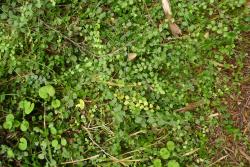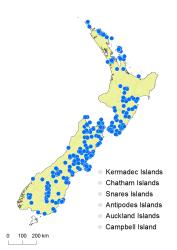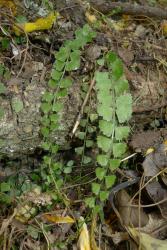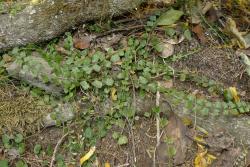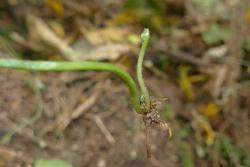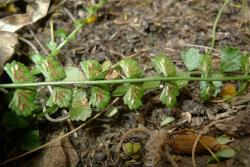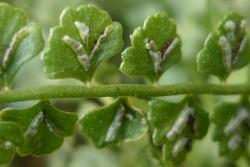- ≡ Chamaefilix flabellifolium (Cav.) Farw., Amer. Midl. Naturalist 12: 269 (1931)
- = Asplenium flabellifolium var. ramosum Colenso, Trans. & Proc. New Zealand Inst. 20: 228 (1888)
Terrestrial or rupestral ferns. Rhizomes short, erect, bearing scales. Rhizome scales acicular or narrowly triangular with filiform apices, 2–6 mm long, 0.3–0.5 mm wide, dark brown, clathrate. Fronds 45–550 mm long. Stipes 5–230 mm long, usually red-brown proximally and abaxially, occasionally becoming green distally, or rarely mostly green, bearing a few small scattered scales. Rachises green or red-brown abaxially, bearing a few small scattered scales, extending up to 200 mm beyond the distal pinnae and rooting at the tips. Laminae 1-pinnate, narrowly oblong or linear, tapering gradually to the apex, 40–310 mm long (excluding distal extension of the rachis), 5–37 mm wide, light green on both surfaces, herbaceous, flaccid, often prostrate, glabrous or with a few tiny scales. Primary pinnae in 4–25 pairs, not or only slightly overlapping; proximal pinnae flabellate or ovate or broadly ovate or deltate, rarely the basal one or two pairs greatly reduced in size, those at mid-lamina flabellate or elliptic or broadly elliptic or obtriangular; the longest pinnae at or below the middle, 3–20 mm long, 3–20 mm wide; pinna apices obtuse or rounded, margins crenate or dentate, sometimes lobed or divided almost to the base in large fronds, bases sessile or short-stalked. Sori away from margin; indusia 1–7 mm long, straight; free margins of indusia entire or irregularly incised. Mean spore size 43–51 μm long, 36–41 μm wide; perispores with numerous crests and ridges.
Asplenium flabellifolium is a very distinctive fern recognised by its prostrate habit, pinnate fronds with flabellate pinnae, and rachises that often extend well beyond the distal pinnae and root at their tips. The ability of the fronds to loop over and give rise to new plants vegetatively at their tips is the basis of the vernacular name walking fern. The form of the flabellate pinnae has given rise to the vernacular name butterfly fern. It is superficially similar to Asplenium trichomanes but the latter species can be recognised by its dark brown polished stipes and rachises, which do not root at the tip.
Rarely, one or more of the pinnae on a frond may be greatly extended and divided, and themselves produce rooting tips. Such an aberrant specimen was the basis of Colenso’s A. flabellifolium var. ramosum (WELT P005143, P005144).
North Island: Northland, Auckland, Volcanic Plateau, Gisborne, Taranaki, Southern North Island.
South Island: Western Nelson, Sounds-Nelson, Marlborough, Westland, Canterbury, Otago, Southland, Fiordland.
Altitudinal range: 0–1100 m.
Asplenium flabellifolium is widely distributed in lowland and montane areas of the North Island. There are scattered populations from Te Paki south through Northland and Auckland to the Bay of Plenty, and then more frequent populations from Lake Taupō to Wellington on the eastern side of the island. It grows from near sea level up to 1100 m in the Kaimanawa Ranges. It is apparently absent from much of Taranaki and Gisborne. In the South Island it occurs mostly east of the main divide in lowland and montane areas, growing from near sea level up to 975 m in the Mackenzie Country. It is absent from most of the west coast, and does not reach Stewart Island or the Chatham Islands.
Also Australia (Western Australia, South Australia, Queensland, New South Wales, Victoria, Tasmania).
Asplenium flabellifolium is a terrestrial fern that spreads by means of its prostrate habit and the rooting tips on its fronds. It occurs under light podocarp, broadleaved, beech, and pōhutukawa forest, under open mānuka, kānuka and low scrub, below Pinus, Salix and Cupressus, under gorse, and often amongst tussocks and introduced grasses. It grows on cliffs, banks, streamsides, rocks, boulders, ledges, crevices, scoria, lava, coastal cliffs, old sand dunes, thermally heated ground, and sometimes around lakes and swamps. Its favoured habitat is dry rock, and it is often associated with Cheilanthes species and Asplenium subglandulosum.
Asplenium flabellifolium is unusual among New Zealand species of the genus in that it has not been recorded hybridising with any other species, despite growing in close proximity to many different taxa (Perrie & Brownsey 2005). Its isolated phylogenetic position in Clade IX of Ohlsen et al. (2014), in contrast to most New Zealand species, which occur in Clade V, may account for this.
2n = c. 210–211, 277–280 (Brownsey 1977). The species is now known to be apomictic in both Australia and New Zealand (Lovis 1973; Brownsey 1977; Tindale & Roy 2002), although an apparently sexual tetraploid population has also been reported from New South Wales (Tindale & Roy 2002). Brownlie (1958) reported n = c. 270 in New Zealand material, but almost certainly erroneously interpreted univalents as bivalents.



